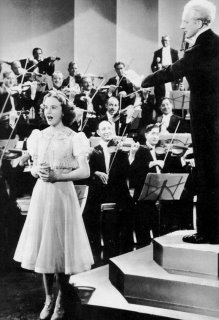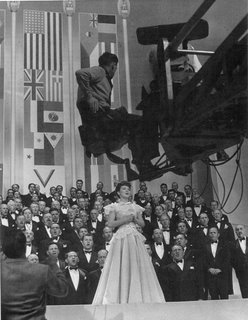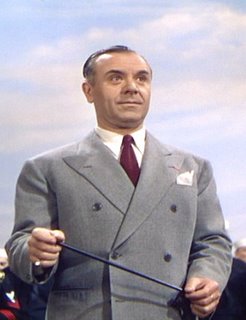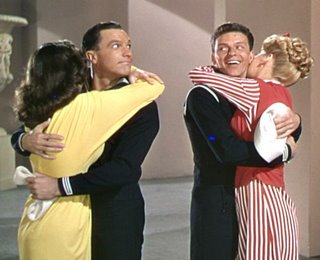
…that sparkling ‘wunderbar’ of musical treasures.
Check reality at the door and leave all your troubles, worries and cynicism behind.
by Nick Zegarac
It has been suggested that the musicals of producer Joseph Pasternak lack sophistication, particularly when quelled against those produced by Pasternak’s rival at MGM, Arthur Freed. The point is a moot one. That Pasternak should even be considered in the same breath as Arthur Freed is a testament to both his savvy and his foresight. It is also a silent nomination for Pasternak to assume his rightful place amongst the all time greatest motion picture producers of the 20th century.
This nomination has often been denied or, at least, eclipsed by Freed’s own illustrious tenure at the studio. Arguably, Freed’s musicals possess the hallmark of more progressive thinking; Freed’s own constant testing of the musicals’ boundaries as an art form generating some of the finest examples of as near to perfection in the genre as possible; Singin’ In The Rain, The Band Wagon, and, An American in Paris, to name but three.
Yet, in paralleling the careers of Pasternak and Freed, film historians have inculcated a great injustice on the Pasternak legacy – for each man’s body of work is comparable to the other only to the extent that both men toiled within the artistic echelons of Metro-Goldwyn-Mayer and were considered, at least for a time, the monarchs of the motion picture musical. Yet, stylistic distinctions abound.

Freed was the true Renaissance man – pursuant of the musical’s constant mutation and expansion; soliciting talent from the New York stage who had a decidedly contemporary strain. By contrast, Pasternak infinitely preferred to remain the gallant holdover from those glorious days of the prewar operetta, when politeness necessitated a libretto, a coy nod and a cultured bow.
Despite Esther Williams claim that he ate spaghetti with his hands, Pasternak was a man very much imbued with the vestiges of a 19th century doctrine for all things impeccably groomed and cultured. Hence, his passion for musicals sought to extol and embrace a time removed, rather than his own immediate present.
While Freed’s fictional musical protagonists were quite often savvy artists of the stage, Pasternak’s were almost without fail common people with no aspirations toward art but whose mundane lives were suddenly transformed and elevated into some grand and magically touched experience. Hence, while Freed’s Tony Hunter (Fred Astaire) in The Band Wagon (1953) is a world weary semi-retired hoofer, desiring a comeback as a Broadway star, Pasternak’s Johnny Donnetti (Mario Lanza) in That Midnight Kiss (1949) is little more than a truck driver who likes to sing and is shortly thereafter ‘discovered,’ thereby making him a truck driver no more.

This ultimate wish fulfillment derived from a Pasternak musical and firmly implanted in the collective cultural mindset is primarily why Pasternak’s films endure today; because they foster within an audience the ideal that no matter our station in life we may one day be called to rise from that plateau into a realm of infinite happiness. Indeed, within each musical excursion Pasternak may very well have been providing his audiences with a subliminal biography.
He was born Joseph Pasternak to Jewish heritage on September 19, 1901 in Szilágysomlyó, then a part of the Austria-Hungary empire, though currently named Şimleu Silvaniei and belonging to Romania. He immigrated as a teenager to the United States and for several years thereafter held various menial positions in the Paramount Studios commissary where he quietly absorbed and observed the daily banter of its professionals both in front of and behind the camera.
Disenchanted with his station and perhaps recognizing that he lacked a formal education to do anything else, at twenty-eight Pasternak returned to Europe where he slowly began to graduate into prominence as a film producer. As he rose through the ranks, Pasternak learned from his contemporaries, amalgamating his tutelage into a distinct style while honing the craft of film making. His success could not have been more ill timed. With the advent of the Nazis rise to power, Pasternak was forced to return to the United States in 1934. But he was no longer a fledgling and he brought with him on his return trip to Hollywood a wealth of experience that immediately caught the eye of Carl Lemmle at Universal Studios in 1936.

Recognizing the feasibility of an articulate precocious fourteen-year-old Canadian soprano Deanna Durbin, who had recently been dropped from her contract at MGM, Pasternak petitioned long and loudly to produce a movie that would showcase her talents. Initially balking at the idea, as musicals were costly in general and Universal was, at this time financially strapped, the film Three Smart Girls (1936) proved a winner. Depression audiences responded to its sugary sweet story while critics furnished accolades upon Hollywood’s latest child protégée.
Ensconced at Universal with a lucrative long term studio contract, Durbin and Pasternak cemented their popularity with Pasternak’s follow up, One Hundred Men and A Girl (1937), an even more eclectic blend of the high and low brow that went on to be nominated for 5 Academy Awards including Best Picture.
Despite a 1938 hiccup that had Pasternak casting himself as the unsuccessful Svengali-star maker to French actress Danielle Darrieux, by the end of the decade Pasternak was Universal’s most prolific producer. His innate ability to blend the heavy (or high brow) with the light and popular rekindled the public’s waning interest in the operetta – a move echoed at MGM with their wildly popular teaming of Nelson Eddy and Jeanette MacDonald. More important – Pasternak’s overriding vision had saved Universal Studios from looming financial receivership. Called upon to aid in the diminishing returns of Universal’s other big star, Marlene Dietrich, Pasternak cast the sultry German chanteuse as a fiery harlot in Destry Rides Again (1939) a seminal western/comedy that effectively deglamorized Dietrich and made her inimitable brand of intercontinental charm excitingly new and real.

However, Pasternak’s genuine forte for pseudo-classical material ultimately remained his bread and butter – though particularly at Universal. Subsequent Deanna Durbin films produced under Pasternak’s aegis all bear his unmistakable flare for operatic extravagance. In It’s A Date (1940) he furnishes Durbin with Musetta’s Waltz and Ave Maria (Pasternak would later remake the film in Technicolor and at MGM with Jane Powell as Nancy Goes to Rio 1950). In It Started With Eve (1941) Pasternak cannot help but allow Durbin the opportunity to trill several breathtaking arias despite the fact that the film’s narrative is set in the present and does not otherwise allow for such musical outbursts.
At this junction in Pasternak’s career, he had made enough of an impression on L.B. Mayer to be wooed away from Universal and over to MGM. This 1941 transition was only slightly br
 ought on by Deanna Durbin’s increasingly temperamental nature (Pasternak himself was hardly a pussycat), her growing up and her considerable plumping out which some at the studio feared would render her unattractive to audiences. Rather, Pasternak rightfully recognized that MGM’s prominence in all aspects of motion picture production would afford him greater opportunity to develop his passion at a studio that both respected and fostered musical talents.
ought on by Deanna Durbin’s increasingly temperamental nature (Pasternak himself was hardly a pussycat), her growing up and her considerable plumping out which some at the studio feared would render her unattractive to audiences. Rather, Pasternak rightfully recognized that MGM’s prominence in all aspects of motion picture production would afford him greater opportunity to develop his passion at a studio that both respected and fostered musical talents.For example, before departing Universal Pasternak had once more attempted to work his magic as a star maker on singer Gloria Jean, an abysmal and failed attempt only partly because Jean lacked star quality – but more importantly, because Universal did not wish to acknowledge the value in cultivating ‘two’ Deanna Durbins for their stable of stars.
At MGM, Pasternak indulged his creative whims on a litany of frothy family fare often with a wartime theme to help buttress the feather weight plots. His first project, Presenting Lily Mars (1943) was one of Judy Garland’s transitional musicals. A child star of the first magnitude, whose indelible mark had already been made in The Wizard of Oz (1939), MGM allowed Pasternak to mature Garland for the title role of a small town girl who makes good on Broadway.

Pasternak next produced Thousands Cheer (1943) a film originally conceived as a modest musical romance between a rather rakish sailor, Eddie Marsh (Gene Kelly) and the colonel’s daughter, Kathryn Jones (Kathryn Grayson). Under Pasternak’s aegis, that modest premise ballooned into an all-star wartime extravaganza – easily one of the biggest and brassiest of its kind and topped by Grayson warbling of the pseudo operatic ‘United Nations on Parade’ (in actuality a variation on a Shostakovich piece).
Subsequent ventures; Song of Russia (1944), Two Girls and A Sailor (1944), Her Highness and the Bellboy (1945) and The Thrill of Romance (1945) were lucrative variations on Pasternak’s tried and proven ingredients for success. Although there were few on the backlot who contended to veer from the producer’s itinerary, The Thrill of Romance’s Esther Williams was not one to keep her opinions secret. Though her clashes with Pasternak were perhaps more reserved than the outbur
 sts that would occur on the set of This Time for Keeps (1947) and On An Island With You (1948) the polite agreement to disagree between these two eventually led to Pasternak’s rather unfair assessment of Williams’ talent as “In the water she was a star. Outside she ain’t!”
sts that would occur on the set of This Time for Keeps (1947) and On An Island With You (1948) the polite agreement to disagree between these two eventually led to Pasternak’s rather unfair assessment of Williams’ talent as “In the water she was a star. Outside she ain’t!”However, one year later the producer would officially ruffle Arthur Freed’s feathers when he secured a minor coup by garnering a Best Picture Oscar nomination with Anchors Aweigh (1945); the delightfully effervescent tale of two sailors on a twenty-four hour shore leave who accidentally meet, then fall in love with, the same girl. The film costarred Gene Kelly and MGM’s own soprano, Kathryn Grayson. It also utilized o
 ne of Pasternak’s favorites – conductor Jose Iturbi in a prominent role and it marked the MGM debut of crooner extraordinaire, Frank Sinatra.
ne of Pasternak’s favorites – conductor Jose Iturbi in a prominent role and it marked the MGM debut of crooner extraordinaire, Frank Sinatra.Midway through production, Pasternak ran into flack from the front office for the commissioning of a costly live action/animated sequence in which Jerry Mouse (of Tom and Jerry fame) trips the light fantastic with Kelly. Initially the sequence had been modeled with Mickey Mouse in mind. However, after making an appointment with Walt Disney – and emphatically told that Mickey Mouse would never appear in an MGM picture – Pasternak and director George Sidney recast the cartoon part with their own resident rodent.
No comments:
Post a Comment